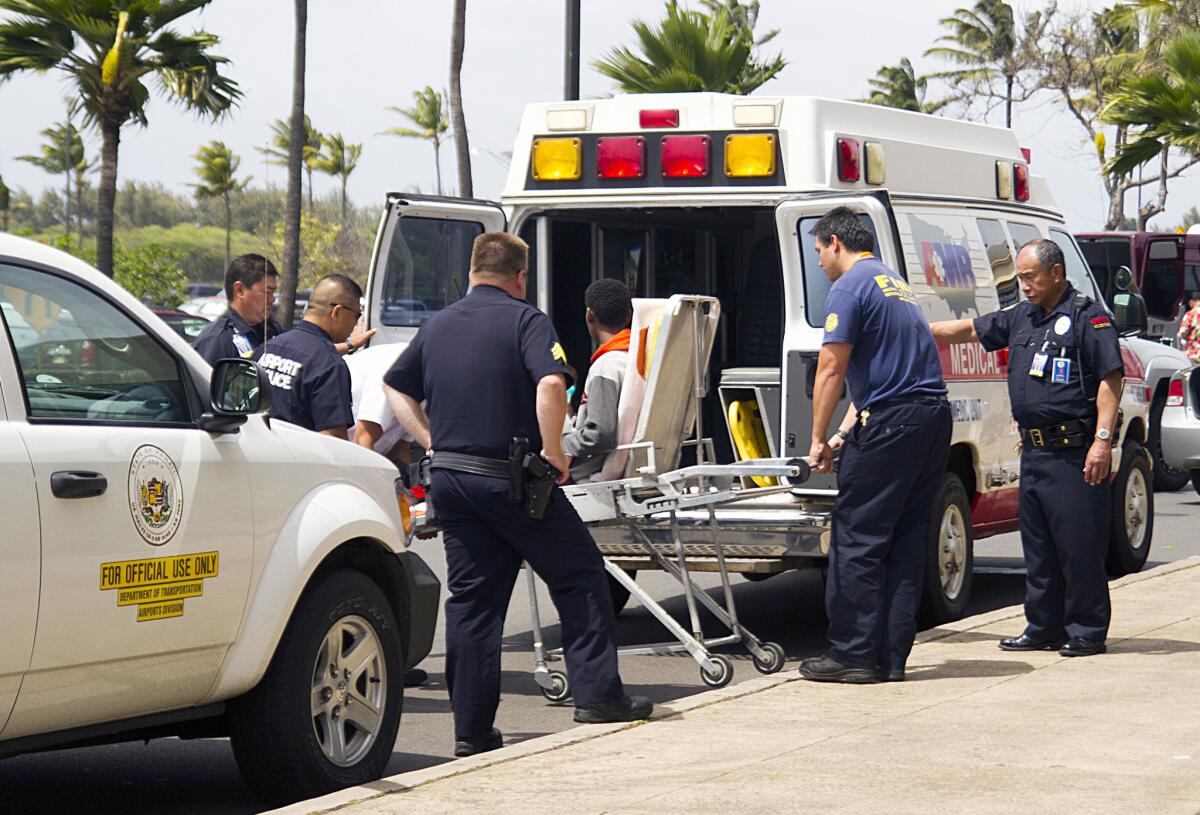Big questions raised by stowaway in Hawaii-bound jet’s wheel well

- Share via
The story of the 16-year-old Santa Clara, Calif., teenager who hopped a fence and stowed away in the wheel well of a Hawaii-bound jet is terrifying and astonishing.
That he survived such a journey is the stuff of miracles.
As my colleague Kurt Streeter wrote, the FAA has reported that stories like these are plausible:
Heat from hydraulic lines in the wheel well along with retained heat in the tires can help keep stowaways warm, the FAA reported. In addition, a plane’s steady climb to high altitudes can allow passengers to drift into an unconscious state as oxygen becomes scarce. As the heat dissipates from the wheel well, a stowaway can develop hypothermia, a condition that preserves the central nervous system. Both hypoxia and hypothermia may resolve as the plane gradually descends for landing, the FAA said.
But how did the kid make it into the wheel well of Hawaiian Airline’s Flight 45 in the first place?
According to the Los Angeles Times article: “Security video from San Jose’s Mineta International Airport verified that the teen hopped a fence and made his way to Hawaiian Airlines Flight 45, then managed to climb up the wheel well of the plane and stow away without being detected.”
At least one aviation reporter has cast doubt on the story: “I don’t believe the kid was in the wheel well,” said John Nance of ABC News, according to USA Today.
I can appreciate his skepticism. We have a deep-seated drive to believe in the miraculous and the heroic, to impose heartwarming narratives on tragic or implausible events.
But let’s accept the story at face value: Teenager runs away from home, hops airport fence, stows away, survives trans-Pacific flight at more than 30,000 feet in subfreezing temperatures, then thaws out just in time for paramedics to throw a lei around his neck and welcome him to Maui on Sunday. Aloha!
On a day such as this, when thousands of runners have converged on Boston, not just to run a fabled marathon, but to take a stand against acts of terror, the idea that someone can hop a fence at an airport undetected and get that close to a plane is truly chilling.
Even more alarming, it’s not unique.
In December, the New York Post reported that Newark Airport’s new Perimeter Intrusion Detection System failed when a 24-year-old man got over a fence and walked across two runways before trying to enter a terminal after running out of gas on the New Jersey Turnpike.
The Post pegged the new system’s price tag at $300 million and said it “includes cameras that watch the airport’s outer fence, which is topped with barbed wire and lined with sensors to detect climbers.”
In August 2012, The Post also broke a story about a jet skier who ran out of fuel in Jamaica Bay and swam to the nearest shore, which happened to be a runway at JFK Airport. He hopped an 8-foot fence and was arrested, still in his bright yellow safety vest, as he tried to enter a terminal.
We’ve spent billions of dollars on airport security and countless hours in slow-moving lines. We’ve suffered the indignity of being patted down, forced to disrobe or to stand in booths with our hands raised and feet apart, all in the name of preventing another 9/11-style attack.
But time and again, random people -- not trained terrorists with evil intentions -- have climbed airport fences and had easy access to planes.
That kid’s trip to Hawaii may be a dream come true for him and his family.
For the rest of the traveling public, it’s the stuff of nightmares.
robin.abcarian@latimes.com
Twitter: @robinabcarian
More to Read
Sign up for The Wild
We’ll help you find the best places to hike, bike and run, as well as the perfect silent spots for meditation and yoga.
You may occasionally receive promotional content from the Los Angeles Times.







